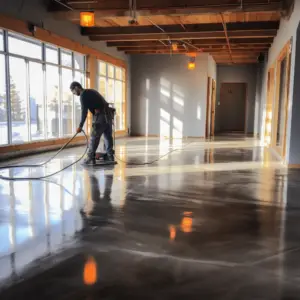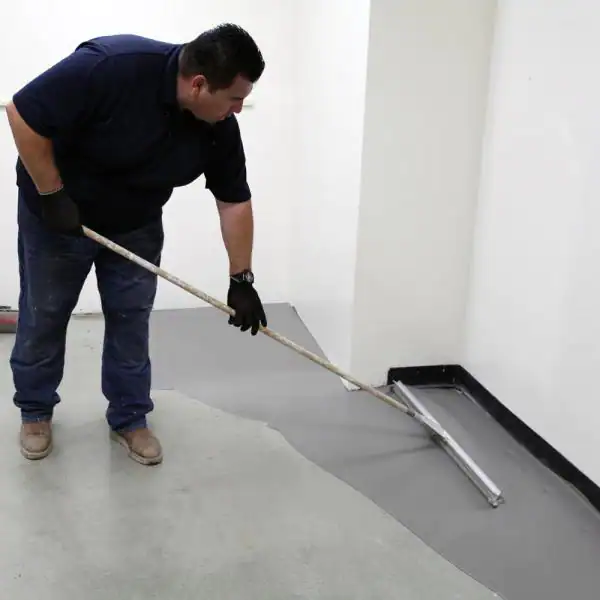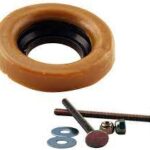Concrete floors can become uneven because of cracks and moisture. Refinishing an uneven base or replacing or adding new flooring on top of an existing concrete floor needs concrete floor leveling.
The most crucial step to make the most of any basement is to attain a level floor. Besides, leveling uneven concrete floors can be done in various ways. So if you have a tight budget, you must be on the hunt for the cheapest option you can use to achieve a level floor.
In this specific article, we have done a detailed write-down on how you can attain a level floor while saving 90% of the overall cost, which is a significant amount more so if the larger space. Let’s dive right in.
Table of Contents
How to Level Concrete Floor Affordably

Don’t Use Self-Leveling Concrete
Self–leveling concrete is an expensive way to level uneven concrete floors, yet you can replicate it using other options that are less burdening and too much cost on your shoulders. The cheapest way to level a concrete floor is to use a specialized sand mix that includes concrete that will quickly spread across the foundation for an even finish.
Invest In Quality Sand Mix
The sand mix is the most cost-effective and best for leveling concrete floors yet affordable. It works well because it has the right consistency, and the result is outstanding and stunning.
Even Spread of the Sand Mix
At this point, you must spread the sand mix using a flat-edged tool that will aid in spreading the sand mix across the floor, although if you don’t have the flat-edged tool, you can use any other device available.
Getting on your knees to find spots that need covering to avoid gaps forming when you are through is advisable.
Be patient at this step, ensuring the sand mix spreads out before watering the sand mix.
Some gaps require a little sand mix added on top to be covered.
Soak With Water
Once the sand mix settles on the floor, the next step is to soak it with water.
It is paramount not to use a pressure washer at this stage to avoid the uneven spread of sand particles. Instead, it is best to sprinkle the water on top to add moisture, which is a must.
Let The Concrete Floor Dry
Please wait for the concrete floor to dry and ensure it dries evenly with no moist patches all over the place. Check the wet patches by placing your hand on top of the surface.
Ensure there are no patches before you move to your next step.
Brush Sand Particles from the Surface’s Top
The final step trickles down to your specific situation. Some outcomes may have sand particles on the surface while others don’t.
Just ensure you check out the state of the sand mix, whether it did or did not spread unevenly. Make use of a bristled brush and sweep the particles aside, thus saving you money and time.
What Are Other Options To Level The Concrete Floor?
Self–Leveling Underlayment
If there are no structural problems, you may level the floor by applying a cement-based self–leveling floor product.
It is a dry substance mixed with water to form a liquid slurry, spread over the floor using a gauge rake, thus settling into low areas and filling them in, creating a level surface.
Self–leveling compound products are versatile, meaning you can apply them on uneven concrete floors but still on even floors, including ceramic tile floors – doing away with the work of tearing out the old tiles.
Therefore, checking to ensure your purchased product is compatible with your floor type is best.
Self-leveling is DIY-friendly and costs an average of $1.50 per square foot when applied 1/8inch thick so the overall cost will depend on the leveled space and the low areas’ depth.
Always follow the manufacturer’s instructions as the products differ slightly. Regardless of your chosen compound, you will take the same steps to prepare the basement beforehand.
How Can You Tell If Your Concrete Floor Is Uneven?

Check the flatness of your concrete by laying the level on various parts of the floor to see whether it applies flat in all spots. Any gap under the level center causes a dip, while if the level rocks back and forth, it is a sign of a heave.
Lay the level with one end on the high part of the floor and the other at the lowest point. Raise the level’s lower end until the bubble is centered, and then measure the distance from the bottom of the level to the floor to get the depth of the dip.
Alternatively, use a “drop” or “marble method.” Drop a few marbles or tiny balls on the floor in different areas around the room and watch where they roll. If they move in a similar direction, that side is lower than the rest of the floor.
If they roll to the other sides of the floor and stop, those areas are probably dipping that you can’t see with your plain eyes.
Heaves are the high areas on the floor, while the dips are the low areas
Determine the Underlying Problem
Before taking on the action to level your floor, it is wise to find out why it is not levelized. That way, you will be able to know whether it requires a pro or you can do it as a DIY project.
Some reasons like age-related settling usually lead to uneven floors, but this should not worry you so much. Additionally, complicated structural problems can make the floor unstable, including foundation issues, a decayed sill plate, a cracked floor joist, and a delaminated subfloor.
Concrete leveling is a procedure to ensure that the concrete surface is even, and there are different ways to do it, ranging from cheap ways like sand mixing to expensive options such as installation.
The leveling of uneven floors ensures the concrete surface is smooth and aids in water drainage. This process applies to both new concrete floors and old and damaged concrete surfaces. It helps to repair any damages, ensuring all the surfaces are smooth and even water drainage throughout the area.
Concrete floor leveling can be cost-effective based on the reason behind the uneven floor. You can undertake it as a DIY project using self-leveling coatings designed to fill holes and cracks or involve an expert. Thus, leveling the floor is paramount regardless of the option you may take, but don’t forget that sand mixing is the most affordable of them all and simplest.


